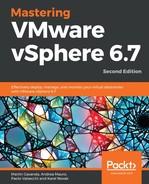Some VMware tools can help by providing reports on your current environment. Most of these tools come with a 60-day evaluation period, which is enough time to get the information needed, and they are listed as follows:
- VMware vSphere Health Check: VMware or professional partner services provide this and it's based on a virtual appliance (or also a standalone package) that can connect to your VMware infrastructure and analyze it, with a great report generator. At this point, it's only available for VMware employees or selected partners. For more information refer to https://www.vmware.com/content/dam/digitalmarketing/vmware/en/pdf/products/vsphere/consserv-vmware-vsphere-health-check-datasheet.pdf
- vSphere Optimization Assessment (VOA): Using this tool you can access the overall reports for your multi-cloud environments from the single console. The primary focus is on the optimization, right-sizing, capacity and costs. For more information refer to https://www.vmware.com/assessment/voa.
- VMware vRealize Operations: The primary purpose of this tool is monitoring, in a proactive way, a virtual (and in some parts, also physical) infrastructure. However, it can also provide some useful insights for capacity and resource planning, and also for resource optimization and resource reclaiming. For more information refer to https://www.vmware.com/products/vrealize-operations.html.
- Hybrid Cloud Assessment: Ideal for companies interested in multi-cloud operations, how to move workloads, optimization, and cost analysis. For more information see https://www.vmware.com/hybrid-cloud-assessment.html
- Virtual Network Assessment (VNA): The VMware tool called vRealize Network Insight (vRNI) is used to extract the data flow across your physical and virtual infrastructure. VNA provides a comprehensive set of reports of traffic flows between your VMs, applications, VLANs or VXLANs.
- vSAN Assessment: Collect data about your existing vSphere storage environment in just one week and get the technical and business recommendations you need for a vSAN design.
- Virtual Desktop Infrastructure (VDI) assessment: This is a specific assessment for a VDI environment that identifies the best candidates both for users and desktops, if they can be moved into a virtual desktop environment, and the order in which those groups and desktops should be virtualized for a successful VDI project.
Then, there are tools from other vendors, or also community scripts, or your personal set of scripts. Note that, VMware does not officially support community tools as they can also vary or change (many scripts are quite old). However, scripting could be the best way to check some specific details, for example, to check whether the number of paths for each shared storage device is what you expect.
The following is a partial list of some of these tools:
- RVTools: Probably the most powerful and straightforward (you have to connect to your vCenter or hosts) tool with which to inventory your environment. It also provides some health check capabilities; for more information, see http://www.robware.net/rvtools/.
- VMware {code} vCheck vSphere: A community script, useful both for inventories and health checks; for more information, see https://code.vmware.com/samples/823/-vcheck-vsphere.
- VisualESXtop: A GUI frontend to the standard ESXtop command for performance metrics of individual ESXi servers—available from the VMware labs page at https://labs.vmware.com/flings/visualesxtop.
Some cloud-based monitoring tools with assessment and/or health check functions are as follows:
- Runecast: https://www.runecast.biz/
- Opvizor: http://www.opvizor.com/
- CloudPhysics: https://www.cloudphysics.com/
Most of them can also verify how best practices are used and applied. The best way to learn more is to try them or ask for a demo:
- Veeam ONE: This provides advanced monitoring, reporting, and capacity planning capabilities designed to help you protect your virtual and backup environments. It also provides some useful reports for the assessment of a virtual environment; for more details, see https://www.veeam.com/one-vmware-hyper-v-monitoring-reporting.html.
- Turbonomic virtual monitor: This is a free product that provides virtualization monitoring and reporting in an unlimited fashion across vSphere, Hyper-V, XenServer, and Red Hat virtualization, not only for network monitoring but also to provide insights into risk and efficiency information and potential improvements across the environment. For more information, see https://turbonomic.com/downloads/virtual-health-monitor/.
The most exciting and useful tools are RVTools and some assessment tools from VMware. (VMware vSphere Health Check is probably the most interesting but unfortunately it cannot be directly used by customers or end users.) Note that there are also situations, such as application dependency mapping, where other tools could be useful—for example, the vRealize Infrastructure Navigator.
